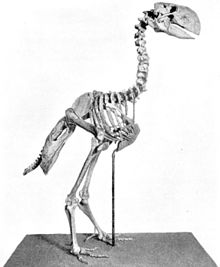
Back Gastornitiformes Catalan Gastornithiformes Spanish سهمگینمرغسانان Persian גסטורניסאים HE Gastornithiformes Italian ガストルニス目 Japanese Gastornithiformes Dutch Gastornithiformes Ukrainian 加斯东鸟形目 Chinese
| Gastornithiformes Temporal range: Possible Neogene and Pleistocene records
| |
|---|---|

| |
| Scientific classification | |
| Domain: | Eukaryota |
| Kingdom: | Animalia |
| Phylum: | Chordata |
| Class: | Aves |
| Superorder: | Galloanserae |
| Order: | †Gastornithiformes Stejneger, 1885 |
| Subgroups | |
Gastornithiformes are an extinct order of giant flightless fowl with fossils found in North America, Eurasia, possibly Australia.[1] Members of Gastornithidae were long considered to be a part of the order Gruiformes. However, the traditional concept of Gruiformes has since been shown to be polyphyletic.
Beginning in the late 1980s and the first phylogenetic analysis of gastornithid relationships, consensus began to grow that they were close relatives of the lineage that includes waterfowl and screamers, the Anseriformes.[2] Recognizing the apparent close relationship between Gastornis and waterfowl, some researchers even classify them within the anseriform group itself.[3] Others restrict the name Anseriformes only to the crown group formed by all modern species, and label the larger group including extinct relatives of anseriformes in the clade Anserimorphae (which this article and related pages have adopted).[4] While the order is generally considered to be monotypic, a 2017 paper concerning the evolution and phylogeny of giant fowl by Worthy and colleagues have found phylogenetic support in finding the mihirungs (Dromornithidae) to be the sister taxon to the Gastornis.[1]
The mihirungs are also another family of giant flightless birds that have been classified as anserimorphs either as crown anseriforms closely related to the screamers (Anhimidae)[5] or the sister taxon to Anseriformes.[3] Worthy et al. (2017) incorporated several new taxa and character traits into existing matrices of Galloanserae resulted in several of their phylogenies to support this grouping.[1] The authors did note the bootstrap support is weakly supported and one of their phylogenies even found gastornithiforms to be stem-galliforms instead.[1] These were also weakly supported.[1] Below is a simplified phylogeny showing their one phylogeny supporting gastornithiforms as anserimorphs.[1]
| Anserimorphae |
| ||||||||||||||||||
However, McInerny et al. (2024) instead recovered mihirungs as crown-group members of Anseriformes related to modern screamers, while recovering gastornithids as members of the Galliformes. They also found weak support for the Sylviornithidae (another enigmatic family of giant birds from Oceania that also went extinct during the Quaternary) potentially being a sister group to Gastornithidae. The lineage containing these two families was found to alternatively represent a group of stem-Galliformes, or a group of crown-group Galliformes more derived than the megapodes but basal to all other members of the group.[6]
In a 2021 paper by Agnolin found the enigmatic Argentinian genus Brontornis from the Miocene deposits, often considered to be a terror bird, found to a gastornithiform sister to the mihirungs.[7]
- ^ a b c d e f Worthy, T.H.; Degrange, F.J.; Handley, W.D.; Lee, M.S.Y. (2017). "The evolution of giant flightless birds and novel phylogenetic relationships for extinct fowl (Aves, Galloanseres)". Royal Society Open Science. 11 (10): 170975. Bibcode:2017RSOS....470975W. doi:10.1098/rsos.170975. PMC 5666277. PMID 29134094.
- ^ Mustoe, G.E.; Tucker, D.S.; Kemplin, K.L. (2012). "Giant Eocene bird footprints from northwest Washington, USA". Palaeontology. 55 (6): 1293–1305. Bibcode:2012Palgy..55.1293M. doi:10.1111/j.1475-4983.2012.01195.x.
- ^ a b Agnolín, F. (2007). "Brontornis burmeisteri Moreno & Mercerat, un Anseriformes (Aves) gigante del Mioceno Medio de Patagonia, Argentina". Revista del Museo Argentino de Ciencias Naturales. 9: 15–25. doi:10.22179/revmacn.9.361.
- ^ Andors, A. (1992). "Reappraisal of the Eocene groundbird Diatryma (Aves: Anserimorphae)". Science Series Natural History Museum of Los Angeles County. 36: 109–125.
- ^ Murrary, P.F; Vickers-Rich, P. (2004). Magnificent Mihirungs: The Colossal Flightless Birds of the Australian Dreamtime. Indiana University Press.
- ^ McInerney, Phoebe L.; Blokland, Jacob C.; Worthy, Trevor H. (2024-06-02). "Skull morphology of the enigmatic Genyornis newtoni Stirling and Zeitz, 1896 (Aves, Dromornithidae), with implications for functional morphology, ecology, and evolution in the context of Galloanserae". Historical Biology. 36 (6): 1093–1165. Bibcode:2024HBio...36.1093M. doi:10.1080/08912963.2024.2308212. ISSN 0891-2963.
- ^ Agnolin, F. L. (2021). "Reappraisal on the Phylogenetic Relationships of the Enigmatic Flightless Bird (Brontornis burmeisteri) Moreno and Mercerat, 1891". Diversity. 13 (2): Article 90. doi:10.3390/d13020090.





